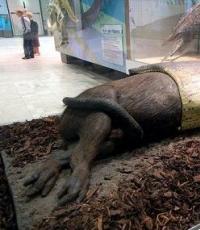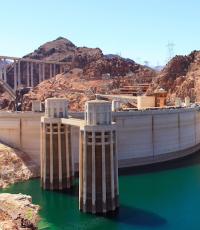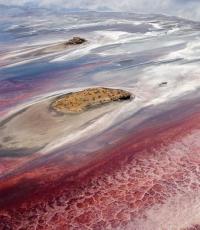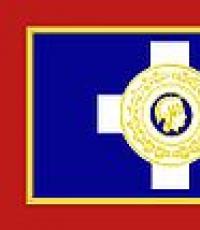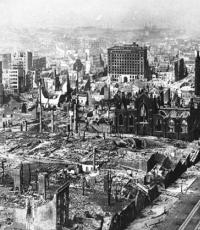Yelagin (Yelagin) Palace. Yelagin Palace History of Yelagin
: 59°58′43″ s. sh. 30°15′18″ in. d. / 59.97861° N sh. 30.25500° E d. / 59.97861; 30.25500(G) (I)
Yelagin Island- an island in the Neva delta, on which the park is located. S. M. Kirov.
Geography
The island is located on the territory of Saint Petersburg, in the Neva Delta, between Bolshaya Nevka and Srednyaya Nevka. The area of the island is 94 hectares. The length from east to west is 2.1 km, from north to south - 0.8 km.
Story
The island was first marked on Swedish maps in 1643. The original Finnish name of the island is “Mistulansaari”, the Russian one is “Mishin Island”, according to the consonance or, according to legend, according to the bears that lived in the forest.
Until 1917, the island, in the possession of the Russian imperial house, was intended for the Dowager Empress Maria Feodorovna, was one of the royal residences. The park has been open to the public since 1826, and has been in the public domain since 1917.
In -1929, the Museum of History and Life was located in the Elagin Palace, since 1930 a branch of the Institute of Plant Growing of the Academy of Sciences. In the 1920s, the western tip of Elagin Island was re-planned (architect L. A. Ilyin, engineer B. D. Vasiliev), a two-tiered terrace was erected with a platform framed by a parapet of light pink granite, along the edges of which stone lions were installed, transferred from the Stroganov dacha.
A park
Almost the entire territory of the island is occupied by the Central Park of Culture and Leisure named after S. M. Kirov, opened in 1932. The name of S. M. Kirov was given to the park and the island in 1934. In -1936, sculptures by M. G. Manizer and E. A. Yanson-Manizer were installed on the Central Alley. During the Great Patriotic War, the pavilions and interiors of the palace were badly damaged. Restoration work began immediately after the war. The park was reopened in 1961, and restoration continued in the 1980s and 1990s. In 1987, the Museum of Russian Arts and Crafts and Interior of the 18th-20th centuries was opened in the palace.
At present, the park includes the Elaginoostrovsky Palace, the Orangery Building (the library and the park administration are located), the Kitchen Building, the Stable Building (exhibitions are held), the Music Pavilion, the Variety Theater, the Oil Meadow, the Large Square, the pavilion of the Granite Quay, etc. There are cafes, clubs, tennis courts, a boat station, a volleyball court, etc. The island has a system of internal ponds, channels and islets on them. One of the islands is occupied in the summer by monkeys who live there freely. There is a small menagerie, where mostly animals are picked up by the servants and visitors of the park.
You can get to the island by three Elagin bridges from Krestovsky, Kamenny islands and from the Primorsky region. The nearest metro stations are Krestovsky Ostrov and Staraya Derevnya.
Gallery
Winter on Elagin Island.JPG
Winter on Elagin Island
Embankment of the Middle Nevka in winter.JPG
Embankment of the Middle Nevka in winter
Flag Pavilion.JPG
Flag Pavilion
Lion on the West Spit of the island.JPG
Lion on the West Spit of Yelagin Island
Embankment of the Middle Nevka.JPG
Embankment of the Middle Nevka
Alley on Elagin Island.JPG
Alley on Elagin Island
Autumn in the park of Yelagin Island.JPG
Autumn in the park of Yelagin Island
Autumn landscape on the ponds of Yelagin Island.JPG
Autumn landscape on the ponds of Yelagin Island
Thumbnail creation error: File not found
Monument to Kirov at the 2nd Elagin Bridge
Bridge on Elagin Island.jpg
Bridge on Yelagin Island
see also
Write a review on the article "Yelagin Island"
Notes
Literature
- Markov V.I. Kirov Islands / Artist L. A. Yatsenko. - Ed. 2nd, rev. and additional - L.: Lenizdat, 1965. - S. 59-112. - 160 s. - 25,000 copies.(reg.)
- Nemchinova D.I. Yelagin Island: Palace and park ensemble. - L .: Art, Leningrad. Department, 1982. - 136 p. - 50,000 copies.
- Gorbachevich K. S. , Khablo E. P. Why are they so named? On the origin of the names of streets, squares, islands, rivers and bridges in Leningrad. - 3rd ed., Rev. and additional - L.: Lenizdat, 1985. - S. 436-437. - 511 p.
- Gorbachevich K. S. , Khablo E. P. Why are they so named? On the origin of the names of streets, squares, islands, rivers and bridges of St. Petersburg. - 4th ed., revised. - St. Petersburg. : Norint, 1996. - S. 301. - 359 p. - ISBN 5-7711-0002-1.
- City names today and yesterday: Petersburg toponymy / comp. S. V. Alekseeva, A. G. Vladimirovich, A. D. Erofeev and others - 2nd ed., revised. and additional - St. Petersburg. : Lik, 1997. - S. 45. - 288 p. - (Three centuries of Northern Palmyra). - ISBN 5-86038-023-2.
- Nemchinova D.I. Palace and park ensemble of Yelagin Island. - St. Petersburg: Creative workshop ViArt-81, 2000. - 207 p. ISBN 5-7678-0025-1
|
||||||||||||||||||||||||||
| |||
Legends of city names - Yelagin Island
On one of the May nights in 1703, a detachment of Preobrazhenians made reconnaissance on the islands of the Neva delta.Home -> Encyclopedia ->Russian soldiers walked cautiously along a small island, the last one to the seaside. Some sort of crack was heard.
The soldiers stopped, took their guns to the butt and began to peer into the green bushes, trying to see where the Swedes were hiding. Suddenly, from behind a large fallen tree, a huge gray bear rose with a roar.
“Fu, you, the abyss,” one of the soldiers burst out, “they thought they would see a Swede, but they ran into a bear. So, this island is not Swedish, but Mishkin.” Or Mishin. Or Mikhailin.
These names are fixed on the maps of 1703. But the island was inhabited long before the founding of St. Petersburg. Fishing settlements and well-kept gardens are marked on old Swedish and Finnish maps.
The island was called Mistula-saari (Bear Island). Perhaps this name was given by Finnish hunters, as well as the names of other islands in the Neva delta: Hare, Elk (now Vasilevsky), Koshachiy (now Kanonersky), Voronii (now Aptekarsky).
The first owner of Mishin Island was Peter's favorite diplomat P. P. Shafirov. Then it was owned by P.Ya.Yaguzhinsky, A.P. Melgunov, G.A. Potemkin, each of whom tried to perpetuate his name in the name of the island. But only the chief chamberlain of the imperial court, Ivan Perfilievich Elagin, to whom the island passed in 1777, succeeded in this completely and for a long time.
One of the most cultured people of his time, Yelagin was known for his wealth, fine artistic taste and hospitality. Under him, a park was laid out with regular and landscape sections, channels and ponds with intricate outlines of the banks were dug, bridges and pavilions, grottoes and pavilions were built.
The island was always popular with high-society Petersburg. In 1816, Yelagin Island was purchased by the treasury and transferred to the use of the mother of Alexander I, Maria Feodorovna, so that in the summer months she could be near her son, who chose the neighboring Kamenny Island for his summer residence.
From this time begins a new chapter in the history of the island. The well-known park builder D. Bush and the young architect Carl Rossi, little known in St.
Together, these two outstanding artists created a brilliant garden and park ensemble with a magnificent palace, outbuildings, each of which appeared as an unexpected architectural masterpiece, garden pavilions.
Yelagin Island became the first town-planning ensemble given by Rossi in St. Petersburg, the first in a series of brilliant ideas that later changed and forever determined the classical look of Venice of the North.
Elaginoostrovsky Palace, Elagin Island, and who is this Elagin?
ELAGIN Ivan Perfilievich (1725-1793) - Privy Councilor, senator, Chief Chamberlain, writer, playwright, translator.
From 1766 Elagin was the director of the court theater and music. His activities left noticeable traces in the history of the Russian theater. Under him, a theater school was founded, a public Russian theater was established in St. Petersburg, the practice of business trips of Russian actors abroad to improve their acting skills and invitations to tours of foreign celebrities was introduced.
Freemason since 1750. For a long time he played a leading role in Russian Freemasonry. In accordance with the diploma received from England, he became the Provincial Grand Master of Masons in Russia. Head of the lodges of the “first Yelagin” and “second Yelagin” unions.
The first name of the island: on pre-Petersburg, Swedish maps it was called Mistulasaari, which means Bear Island. It must be assumed that this name was given by Finnish hunters in the same way as to other islands of the Neva delta: Hare, Elk (now Vasilevsky), Koshachiy (now Kanonersky), Voronii (now Aptekarsky), etc. http://www.masons.ru/Publications/bio.ht...
The island was called that - Mishin, or Mikhailin - until that time, until in 1777 the island was acquired by the chief chamberlain of the imperial court, Ivan Perfilievich Elagin. The name stuck - the island retained this name under all subsequent owners. The palace itself, in the form in which it has come down to us, has little to do with Elagin himself - at the beginning of the 19th century it was bought by Alexander I for his mother, Empress Maria Feodorovna, who was already having a hard time going to the country residences of Pavlovsk and Gatchina.
Peter Islands 1.
In the very heart of Old Petersburg, next to the house of Peter the Great, the northern branch, Bolshaya Nevka, separates from the Neva River. It is large because further on its way to the Gulf of Finland it breaks up into small and large islands and breaks up into three Nevkas: Bolshaya, Srednyaya and Malaya. The islands are the most romantic places in St. Petersburg, the most beloved home parks. Foreign tourists do not come here as often as in the center, there is simply not enough time for everything. The most beautiful of the islands is Yelagin.
The history of Yelagin Island goes hand in hand with the history of St. Petersburg and all of Russia. And it begins in 1709, when Peter, bestowing lands on his most faithful comrades-in-arms, granted the island, which was then called Mistulansaari, or Mishkin Island in Russian, to Vice-Chancellor P.P.Shafirov. Mishin, Mishkin - because bears lived on a forested island.
The place, apparently, was unenviable, because throughout the 18th century the royal gift passed from hand to hand, was sold, bought and bought up. Until in 1777, Ivan Perfilievich Elagin acquired it from the legendary Prince Grigory Potemkin.

He was one of the most enlightened people of his time, a historian, poet, freemason, and a prominent statesman. And from that time on, the island he acquired received his name. I.P. Elagin turned Mishkin Island into a wonderful park in the English style: with ponds, canals, gazebos, bridges. Part of the forest was cut down and planted with trees, creating the unique landscapes of Yelagin Island. Some of these trees have survived to this day - they are very cherished. At the eastern end of the island, a palace was built in 1786. Presumably the author of the project is Giacomo Quarenghi.
In 1793, I.P. Elagin dies, and the island again passes from one heir to another. Only in 1817 the island was bought by the Imperial Cabinet as the residence of the imperial family. From 1818 to 1826 the island was completely rebuilt. A new palace was erected according to the project of Carlo Rossi, new service buildings were built: the Kitchen building, the Stable building, the pier, greenhouses, several summer pavilions.

In 1826, Yelagin Island was opened to the public and became a favorite place for secular walks.
In Soviet times, the park became a national property, the Central Park of Culture and Recreation.
For a long time, the Yelagin Palace was used by various scientific institutions, and only after the war, restored, it became a museum complex.

In 1920, the western part of the island - Strelka - was decorated with a two-tiered granite embankment and two stone lions from the Stroganovs' dacha.
But the lions of the Elagin Palace are especially loved. How many generations of children sat on their warm backs!!!

Since the 60s and 70s, when I literally grew up in this park, a lot has changed. Wooden bridges were replaced by reliable cast iron ones. A lot of new fun and entertainment appeared. Even your own zoo. Even monkeys live on one of the islands. But the main thing has remained unchanged - the boat stations on the ponds, through which you can travel around the island from end to end. And in winter, these ponds become fun skating rinks!
Petrogradsky district is a great place to relax. This is one of the oldest districts of St. Petersburg. Here you will find many historical monuments, noisy avenues and quiet streets, parks and squares. If you decide to relax in St. Petersburg, an excellent solution would be to rent an apartment on Petrogradskaya.
Today we will tell you the story of one of the most picturesque places in St. Petersburg - Yelagin Island.
18th century
Creating a new capital of the Russian Empire on the banks of the Neva, Peter I sought to equip the nearby territories, distributing them to his associates. The first owner of the island in 1709 was Vice-Chancellor Baron Pyotr Pavlovich Shafirov (1669–1739), a well-known diplomat and statesman. During the 18th century, nine noble owners changed around the island. During this time it has changed its name several times. Its original name sounded in Finnish "Mistula-saari". Then the island was called Mishin or Mikhailin. According to the legend, the patrol of Russian soldiers met a big bear here. The island received its current name in honor of the fifth owner - Ivan Perfilievich Elagin, chief chamberlain of the imperial court.
19th century
By the beginning of the 19th century, the maintenance of a large estate located on Elagin Island became too costly, and the last owner of the island, Grigory Vladimirovich Orlov, sold it in 1817 to the treasury for three hundred and fifty thousand rubles.
Since that time, a new stage in the life of Yelagin Island begins. For the next hundred years, he passes into the possession of the Russian imperial house. In 1818, by decree of Emperor Alexander I, a “committee was formed to rebuild the former Elagin Palace, build a kitchen and stable buildings, remake a large stone greenhouse and other things on Elagin Island.”
C. Rossi was appointed the chief architect of the construction. He had to rebuild the palace, create new service buildings and equip the island for the summer stay of the Dowager Empress Maria Feodorovna. The architect did not limit himself only to the reconstruction of the palace and office premises, but transformed the entire island as a whole.
Rossi was supposed to carry out construction work, and the improvement of the island and the redevelopment of the park were entrusted to an experienced garden master Joseph Bush, Jr., who became famous for creating Pavlovsky and Tsarskoye Selo parks. The master plan of the palace ensemble on Elagin Island, which consistently carried out the principle of a landscape park with its asymmetry and picturesqueness, was developed jointly by Rossi and Bush. Through their efforts, the island, “torn out of the swampy St. Petersburg soil with great difficulty, was turned into Isola bella of the Russian North -“ a beautiful island ”, and the park on it - into one of the most beautiful parks in Europe.
During the two construction seasons of 1818 and 1819, the palace was rebuilt. The date of completion of construction and finishing works, as well as interior decoration is considered to be 1822.
For a hundred years, the island remained in the possession of the Romanovs and was a favorite vacation spot for the imperial family. Over the years, a unique collection has been formed in the Elaginoostrovsky Palace, the basis of which was laid by works originally designed by the great architect, master of interior design and arts and crafts, Carl Rossi.
20th century
By decision of the Central Committee of the All-Union Communist Party of Bolsheviks and the Council of People's Commissars of the USSR dated December 2, 1931, the TsPKO park was opened on Elagin Island. The opening of the folder took place on August 05, 1932.
After the death of S. M. Kirov in 1934, Krestovsky, Elagin and Kamenny Islands were renamed Kirov Islands, and the Central Park of Culture and Recreation was named after S. M. Kirov. Numerous sports grounds and attractions are being created on the island.
